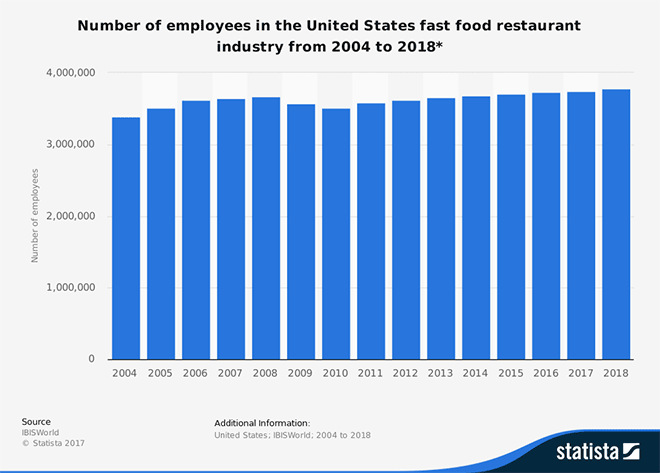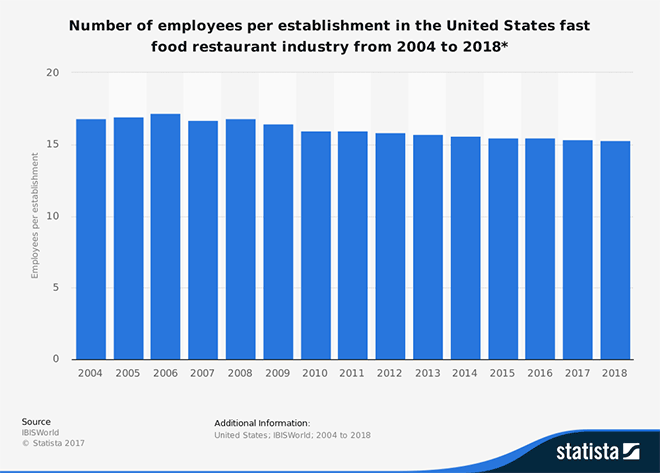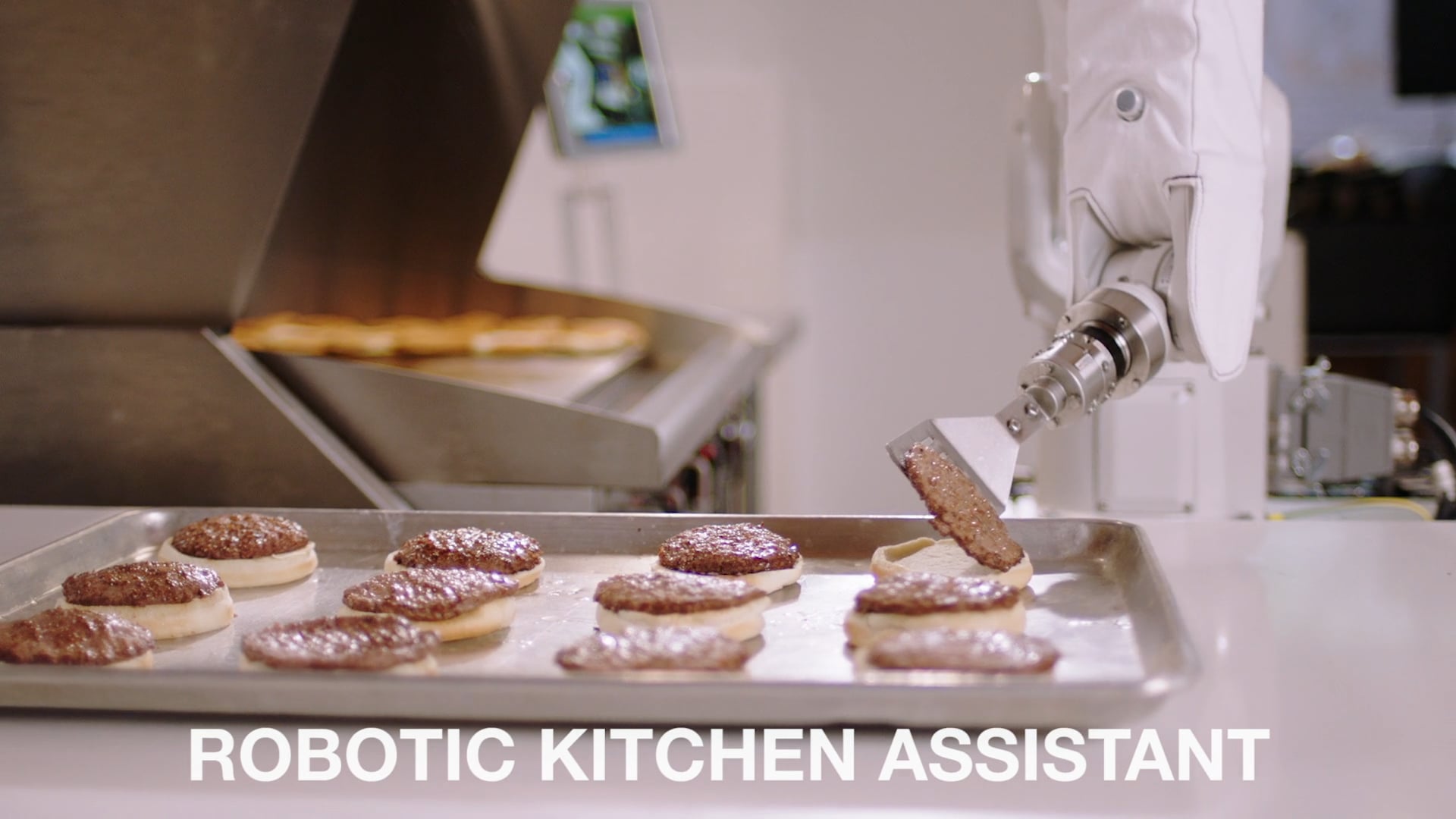Headquartered in Pasadena, Miso Robotics call themselves a robotic kitchen assistant developer. Since securing $3.1 million of round 1 funding at the beginning of July they’ve not messed about. Quicker than Gordon Ramsay can bellow an expletive at a hapless restaurant owner, Miso have unveiled Flippy, a burger flipping robot. And so they should, seeing as Miso’s raison d’etre is to focus on, in the words of crunchbase, “using AI and automation to solve the high pain points in restaurants and food preparation”.
Armed with laser sensors and pimped-out with 3D and thermal scanners for eyes, Flippy can flip burgers twice as fast as a human. The smart robot has been endowed with the ability to identify and track burger patties on a grill, flip them and place them on a burger bun. At the moment Flippy is a bit of a one trick pony, you’ll still need good old homo sapiens to place burger patties on the grill, cut vegetables and add cheese. Thus rendering human participation in the process to that of a mere assistant to the robotic kitchen assistant. For now, at least. Deep learning ability means Flippy can adapt and in the future will be able to perform an increasing amount of restaurant functions.
The latest story-arc for Miso’s burger flipping robot has Flippy starting a ‘rites of passage’ work placement in a local CaliBurger restaurant. Flippy, by all accounts, has already started flipping burgers, behind a large screen à la Wizard of Oz. A security precaution against prying, non-3D eyes. After Flippy’s Pasadena stint is finished, the Hollywood ‘rites of passage’ format is to be ditched in favor of an ‘extending the trial in 50 international CaliBurger locations over the next two years’ story format. Thus, killing stone dead, the nostalgic Johnny 5/Short Circuit feel-good comparison we were cultivating. Franchise reboot anyone?
Why CaliBurger for the burger flipping robot?
Here is where CaliBurger have been rather astute. Or rather, Cali Group, the parent company of CaliBurger, who co-founded Miso Robotics in 2016. It’s just a typical tale of a burger chain restaurant creating a food robotics start-up, developing a working proof of concept and attracting millions in venture capital funding.
Read More: Could You Stomach Hongeo? Meet South Korea’s Smelliest Food
Cali Group Chairman, John Miller states “Our investment in Miso Robotics is part of our broader vision for creating a unified operating system that will control all aspects of a restaurant from in-store interactive gaming entertainment to automated ordering and cooking processes, ‘intelligent’ food delivery and real-time detection of operating errors and pathogens.”
If Miso doesn’t work out then Cali Group also have interests in Esports platform Super League Gaming, Fun Wall and PopPacks. Fingers in lots of pies it would seem.
What is the fast food burger industry worth?
It’s hard to quantify exactly how much the burger chain market is worth. But we’ve found one source that’s had a stab at working it out, based on data from Technomic. The Restaurant Business website estimates that collectively the top 500 burger chains served-up a supersized $75.5 billion in sales for 2016. Meaningless fact time— that’s enough to buy enough Big Mac’s to circle the earth 150 times. Another one? It’s enough to buy all 7.4 billion humans 2.84 Big Mac’s each. If we all banded together we’d probably get some sort of group discount or maybe even a meal deal.
So, selling burgers is hugely lucrative. What’s more, if we cast an eye over projections for the fast food industry in general, it’s growing at a very healthy rate. Zion Market Research report that the global market in Fast Food will grow to be worth $690.80 billion in 2022. They say it was worth $593.63 billion last year. Using the figures from both Technomic and Zion, slap together some basic arithmetic, and we estimate that by 2022 the fast food burger market could be worth $87.85 billion. That’s going to pay for a lot of Wall-E’s.
The other players in town
Miso Robotics are not the only company making a play in the automated fast-food kitchen arena. Momentum Machines, is a veteran of the scene, founded way back in 2009, in the South of Market district, San Francisco. Momentum are no strangers to funding rounds themselves and secured an injection of $18.39m from investors in June of this year.
Momentum Machines differs from Miso Robotics in the scope of their immediate objective. Whilst Miso are focused on the burger cooking element of the process, Momentum want to automate the whole shebang. That’s right, full production of gourmet burgers, start to finish, and no puny humans to put a spanner on the hotplate. Sound ridiculous? They’ve already done it. Momentum burst onto the scene in 2012 when they produced their first burger robot. More impressive was the fact that their machine could produce 400 made-to-order burgers per hour.
Flippy and co. are ahead of the self-driving curve
Flippy’s introduction is not entirely without controversy. Because job losses. We’re regularly exposed to a steady drip-drip of media commentary surrounding advances in self-driving-anything. The more mundane targets of automation have had decidedly less razzamataz surrounding their development timelines. So whilst we’re all oohing and aahing over the fact that a self-driving Prius can perform donuts without a back-up driver (it can’t—we made that up), the fully autonomous driving concept has not been rolled out to the masses, yet.
Read More: Nutella Café Opens Doors In Chicago – Nom Nom Nom
The White House predicts 3.1 million job losses among drivers in the US when self-driving vehicles become the norm. Critically, the timeline on all of that varies wildly depending on who you ask.
Unsurprisingly Silicon Valley is a hub for vehicle automation and 27 companies currently have permits to operate 180 autonomous vehicles for test purposes. Oh, small catch, there needs to be a bona fide human in the car, it needs a steering wheel, oh and foot controls. Just in case, you know?
If you’re stymied by California state laws do a ‘Waymo’ and test in Texas. Texas has none of the self-driving hang-ups that plague prudish California. In fact Steve Mahan, former director of the Santa Clara Valley Blind Center, was driven around Austin by a fully autonomous car in 2015. He survived.
California does seem to be loosening up and new laws have been proposed that permit cars on the open road without a back-up driver, steering wheel or foot controls. But a complete sea-change in favor of total automation? That could take a while.
Ok, so we’ve digressed, but at least 3.1 million drivers can indulge a collective sigh of relief. In the short term at least. Flippy though? Well Flippy is a different beast entirely.
Impacting quick service restaurants
Unlike self-driving-anything, Miso Robotics are literally months away from rolling it’s robotic kitchen assistant out en-masse. That could mean imminent job losses of a kitchen assistant nature in the food service industry.
So, what’s at stake? There are just over 3.7 million people employed in the US fast food industry.

3.7 million is a vast number. Especially when industry analysts excel at blurting gargantuan numbers around in Tourette-like outbursts . It’s hard to quantify how that 3.7 million number correlates with the staffing numbers at your local Burger King, Wendy’s or KFC. You know, in real terms, those people you might actually know. Maybe you’re thinking a hefty wedge of that 3.7 million headcount is employed in corporate functions such as Marketing, Accounting and Supply Chain Management? Nope, ballpark 5-6%, using data from Statista we can break those employee numbers down per establishment, in the US at least, and see a clearer picture of how many could be affected on the front line.

The graph above shows the average headcount at a quick service restaurant in 2017 is 15.38. According to Statista there are 232,611 fast food establishments in the United States. So the estimated figure of the staff headcount at risk from automation is 3,577,557 million. And yeah, we know, that’s roughly, but it is at least based on quantifiable data.
Shaving the fast food head count
Back to Flippy and we can now begin to see how the burger flipping robot could impact the bottom line in real terms. Remember that average 15.38 headcount per establishment? Along comes Flippy and maybe that headcount has dropped to 13.38. We’re guess-timating two workers over two shifts. If Flippy or another equivalent becomes the industry norm? Well here’s the thing, across those 232,611 fast food outlets you’ve just automated 464,000 jobs. And that’s just America, extrapolate that out for the global consequences.
Let’s not all flip the bird at Flippy though. In February 2017, Wendy’s announced the implementation of self-service ordering kiosks in 1000 store locations, that accounts for 15% of it’s restaurants. So what’s that average figure now if you’ve invested in automated kiosks and a burger flipping robot? 10 staff per establishment? You’ve just trimmed 1.25 million jobs. Could it be as low as 8? Now we’re talkin’, that’s 1.7 million jobs.
Technological progress and the Great decoupling
But hey, this is progress and you can’t persecute inventors and entrepreneurs for getting ahead. Not many people have called for the heads of Tim Berners Lee, Thomas Edison or James Watt, as far as we know.
Middle class America embraced the affordable Ford Model T developed for the masses by Henry Ford. Unlike Ford’s failed Amazonian Utopia, Fordlandia, the Model T revolutionized transportation.
Advances in technology which have changed the landscape of industries are well documented. In 1910 there were 11.77 million people employed in agriculture in the United States. Fast forward to 2015 and that number has dropped to 2.05 million.
So, we’ve been here before and bought the T-shirt. But economic data collected since the post WW2 era shows that despite technological advancement, employment, wages and productivity rose steadily and in proportion with one another. Happy days, and if you were an American worker lacking a college degree, no problem, you would still experience a year on year rise in your standard of living.
That is, until the 1980’s. Things turned and we’re not just talking about hairstyles. Median incomes started to falter. Today, if you adjust for inflation, the average US household earns less than it did in 1998. Private sector job growth has also stuttered, and we can’t blame the 2008 recession, this trend was observed as far back as 2000. But productivity is up and for the first time we’re seeing technology not creating enough new jobs to compensate for the jobs it’s made obsolete.
How close is the robot utopia?
Greg Creed, the CEO of Yum Brands, owners of Pizza Hut, KFC and Taco Bell thinks automation will have a significant impact on the industry within the next decade. Interestingly, Creed, disagrees with US Treasury Secretary Steven Mnuchin on the subject of automation. Mnuchin, apparently a wannabee military jet honeymooner , believes automation won’t threaten US jobs for another 50 -100 years. Creed, presumably chuckling between mouthfuls of Zinger Burger, responded, “Yeah, I would disagree with that. I believe, having listened to the people in the artificial intelligence area – and we’re starting to work with them in that area – I think that is way too long. I think it’s going to happen – I don’t think it’s going to happen next year or the year after, but I do believe that probably by the mid ’20s to the late ’20s, you’ll start to see a dramatic change in sort of how machines sort of run the world.”
In fact Yum Brands in China are testing the waters of automation in their flagship Pizza Hut restaurant in Shanghai, China. The restaurant called ph+ is a concept restaurant with a cute robot, named Casper, that can guide diners to their tables. The robots don’t take orders or serve food, indicating this is very much a case of automation-light and probably more of a gimmick to get customers through the door. In fact one restaurant goer and blogger observed that the robot “really takes it’s time“.
Staying in China with the robot theme and there have been reports of three restaurants in the city of Guangzhou sacking robots. In fact, two of the three restaurants are now closed. Although we suspect the robots are not entirely to blame. A restaurant co-worker who firmly believes in kicking a robot when it’s down had a few things to get off his chest. “The robots weren’t able to carry soup or other food steady and they would frequently break down. The boss has decided never to use them again,” another worker bemoaned their lack of skills. “They can’t take orders or pour hot water for customers.”
So it’s certainly not a smooth path to automated robot utopia, in China at least, where front of house robots seem to be reserved for pissing of their human co-workers and performing a more gimmicky role to attract custom.
Flippy is powered by deep machine learning
Flippy is clearly on another level from it’s almost ornamental Chinese counterparts. With an AI that has deep machine learning at it’s core, the burger flipping robot could easily adapt to learn and master new roles in the kitchen.
“We say it gives eyes and a brain to the industrial robotic arm,” explains David Zito, the Miso Robotics CEO. “It doesn’t just see what’s going on, but it actually is trained to understand, through thermal sensors, the delta between the temperature of the patty and the grill.” Zito adds, “It will do 150 burgers an hour, but we believe over time it will get up to 300 burgers an hour,” impressive figures and a glimpse into a future where automation will have a huge impact on society.
We’re off to bask in the robotic nostalgia of Wall-E while we still have a job. Doo-dloo-doo-doo-doo, I’m singing in the rain…


